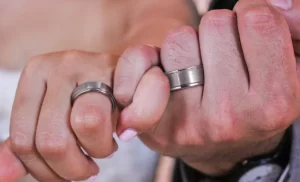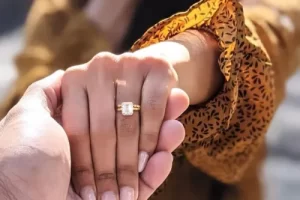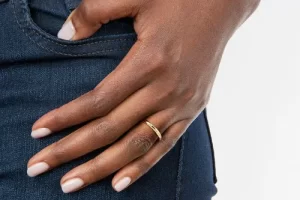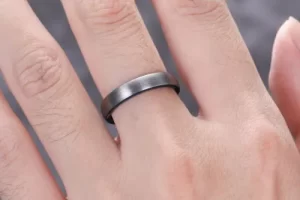For many jewelry shoppers, one of the most confusing questions is whether men’s and women’s ring sizes differ. On the surface, it seems obvious they would – after all, men’s hands and fingers tend to be larger on average. However, the reality is more nuanced.
In this comprehensive guide, we’ll untangle the myth and facts around gendered ring sizes, so you can confidently shop for rings.

Do Men and Women Use Different Ring Size Charts?
Surprisingly, no! Both men’s and women’s ring sizes are measured using the same universal standard. This chart measures the inside circumference of a ring in millimeters. Sizes range numerically from 1 to 16, with quarter sizes in between the whole numbers (size 5 1/4, size 7 1/2, etc.).
So technically, there is no separate “men’s” or “women’s” ring size chart. The metrics are identical.
What’s the Average Ring Size for Men and Women?
While the sizing chart is the same, research shows there are differences in the average ring size preferred by men and women:
- Women’s average ring size:Sizes 6 to 8.5
- Men’s average ring size:Sizes 9 to 10.5
This discrepancy highlights a biological reality: the average man’s fingers and hands tend to be larger than the average woman’s, necessitating a larger ring size. Factors like bone structure, muscle mass, and simple height/weight differences influence this.
So, while the size spectrum is constant across genders, the averages demonstrate why many men opt for larger ring sizes than most women.

Beyond Size – How Width and Style Matter
Ring sizes tell only part of the story. A ring’s physical width and aesthetic style also have a major impact on fit and overall look.
Width
- Men’s ringsrange from 4mm to 10mm wide or wider. The substantial width allows their larger fingers to fit comfortably.
- Women’s ringsusually span from 2mm to 4mm wide. This slender profile achieves proportionality on smaller, more delicate fingers.
So men don’t simply size up – they also need an entirely different bandwidth to achieve the optimal fit.
Style
As widths differ, masculine and feminine aesthetics impact ring selection across genders.
- Men’s ringsoften feature bold metals, large-faced stones, and intricate details – elements that require the stability of a thicker band.
- Women’s ringstend to incorporate more delicate accents like thin bands or clusters of smaller stones – details that would overwhelm a wider profile.
Bandwidth and style combine to create a balanced, gender-specific appeal.

Finding the Perfect Fit: Key Considerations
To find complete ring satisfaction, keep these essential tips in mind:
- Accurately measure your finger.Sizing technology has advanced to body scanning and online sizing kits for convenience. Know your exact size before shopping.
- Mind the width.Consider wider bands if you have larger fingers and hands. This allows a comfortable, customizable fit.
- Prioritize comfort.A properly sized ring should slide over the knuckle easily but feel secure on the finger’s base. If it spins or feels too snug, reconsider the width or size.
- Reflect on your style.Ring shopping is hugely personal. Seek designs that make you feel confident and capture your aesthetic.
While men may need larger sizing, everyone deserves a comfortable, confidence-boosting fit. By understanding the nuances around ring sizes, widths, and styles, you can curate the perfect ring to celebrate your sensibilities.
The Takeaway: Celebrate Your Unique Style
While general size averages may differ between men and women, the metrics remain constant. Rather than get lost in separate categorization, finding a ring that encapsulates personal comfort and style is the most important thing.
Men deserve ornamentation just as delicate and meaningful as women. And many women opt for widths and designs outside the narrowly “feminine.” The beauty of rings lies in their symbolism – of relationships, milestones, commitments, and self-expression. They represent the deeply personal.
So leverage the universal size chart, but focus on discovering your perfect style fit. The result will be a ring that feels like it was crafted just for you in all the ways that matter.

FAQs
Still, have some lingering questions? Here are answers to some frequently asked questions:
- Do men and women technically have their own separate ring size charts?
No. One standardized universal ring size chart is used for both men and women. This chart measures the interior circumference of a ring in millimeters, from sizes 1 to 16, including quarter sizes.
- What about those “conversion charts” translating men’s sizes to women’s?
These “conversion” resources cause more confusion than clarity. Since the sizing metrics are identical, direct conversions based on gender aren’t accurate or helpful for finding one’s true, comfortable fit.
- How do I determine my perfect size?
Getting your fingers sized by an expert jeweler is ideal for personalized accuracy. But home sizing kits and even well-fitting existing rings can help narrow your ideal fit too. Focus less on conforming to “average” sizes and more on discovering your own perfect number.
- If men’s hands are larger on average, are their knuckles also generally bigger?
Yes. Another biological difference between most men and women is knuckle size, which is generally more prominent and larger on men’s hands. This is why factors like bandwidth and style make such a difference in choosing a men’s ring for the most comfortable fit.
- Does my ring size ever change?
For most adults, ring size remains static once full physical maturity is reached. But factors like significant weight gain/loss, pregnancy, injuries causing swelling, arthritis, and aging can all impact finger size somewhat over time. If you notice current rings feeling tighter or looser than before, it may be time to get re-sized.

